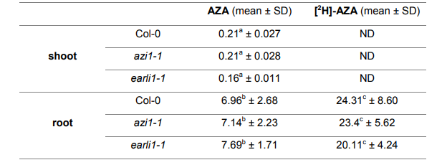Underground azelaic acid-conferred resistance to Pseudomonas syringae in Arabidopsis
- Ciudad Universitaria Universidad Nacional de Córdoba (Argentina). Centro de Investigaciones en Quimica Biologica de Cordoba
- Univ. of Chicago, IL (United States). Division of Biological Sciences
- Univ. of Chicago, IL (United States). Molecular Genetics and Cell Biology
- Dong-A University (Korea). Department of Genetic Engineering
- Oak Ridge National Lab. (ORNL), Oak Ridge, TN (United States). Biosciences
Local interactions between individual plant organs and diverse microorganisms can lead to whole plant immunity via the mobilization of defense signals. One such signal is the plastid lipid-derived oxylipin azelaic acid (AZA). Arabidopsis lacking AZI1 or EARLI1, related lipid transfer family proteins, exhibit reduced AZA transport among leaves and cannot mount systemic immunity. AZA has been detected in roots as well as leaves. Thus, the present study addresses the effects on plants of AZA application to roots. AZA, but not the structurally related suberic acid, inhibits root growth when directly in contact with roots. Treatment of roots with AZA also induces resistance to Pseudomonas syringae in aerial tissues. Additionally, these effects of AZA on root growth and disease resistance depend at least partially on AZI1 and EARLI1. AZI1 in roots localizes to plastids, similar to its known location in leaves. Interestingly, kinases previously shown to modify AZI1 in vitro, MPK3/6, are also needed for AZA-induced root growth inhibition and above ground immunity. Finally, [2H]-AZA applied to the roots does not move to aerial tissues. Therefore, AZA application to roots triggers systemic immunity through an AZI1/EARLI1/MPK3/MPK6-dependent pathway and AZA’s effects may involve an additional mobile signal(s).
- Research Organization:
- Oak Ridge National Lab. (ORNL), Oak Ridge, TN (United States)
- Sponsoring Organization:
- USDOE Office of Science (SC), Biological and Environmental Research (BER)
- Grant/Contract Number:
- AC05-00OR22725
- OSTI ID:
- 1468048
- Journal Information:
- Molecular Plant-Microbe Interactions, Vol. 32, Issue 1; ISSN 0894-0282
- Publisher:
- APS Press - International Society for Molecular Plant-Microbe InteractionsCopyright Statement
- Country of Publication:
- United States
- Language:
- English
Web of Science
Regulatory function of EARLI1-LIKE HYBRID PROLINE-RICH PROTEIN 1 in the floral transition of Arabidopsis thaliana
|
journal | January 2020 |
Rhizosphere microbiome mediates systemic root metabolite exudation by root-to-root signaling
|
journal | February 2020 |
AzeR, a transcriptional regulator that responds to azelaic acid in Pseudomonas nitroreducens
|
journal | January 2020 |
Similar Records
Wound-induced polypeptides improve resistance against Pseudomonas syringae pv. tomato DC3000 in Arabidopsis
Impaired Chloroplast Biogenesis in Immutans, an Arabidopsis Variegation Mutant, Modifies Developmental Programming, Cell Wall Composition and Resistance to Pseudomonas syringae






